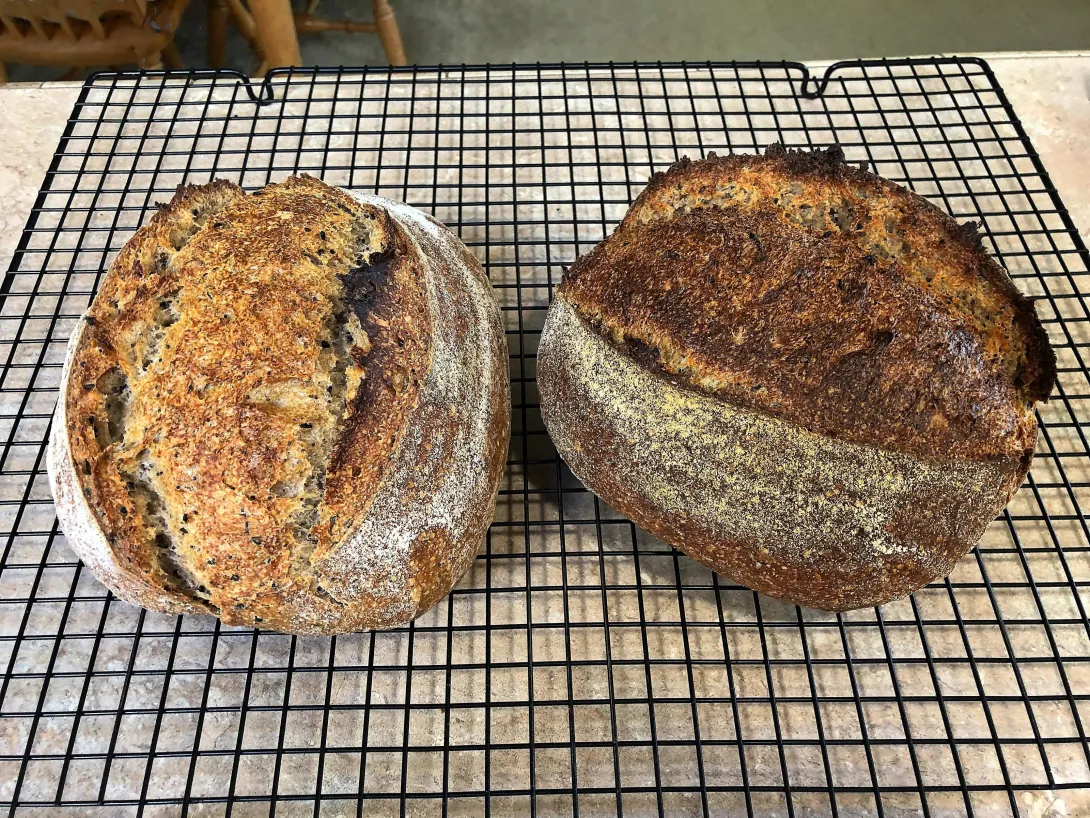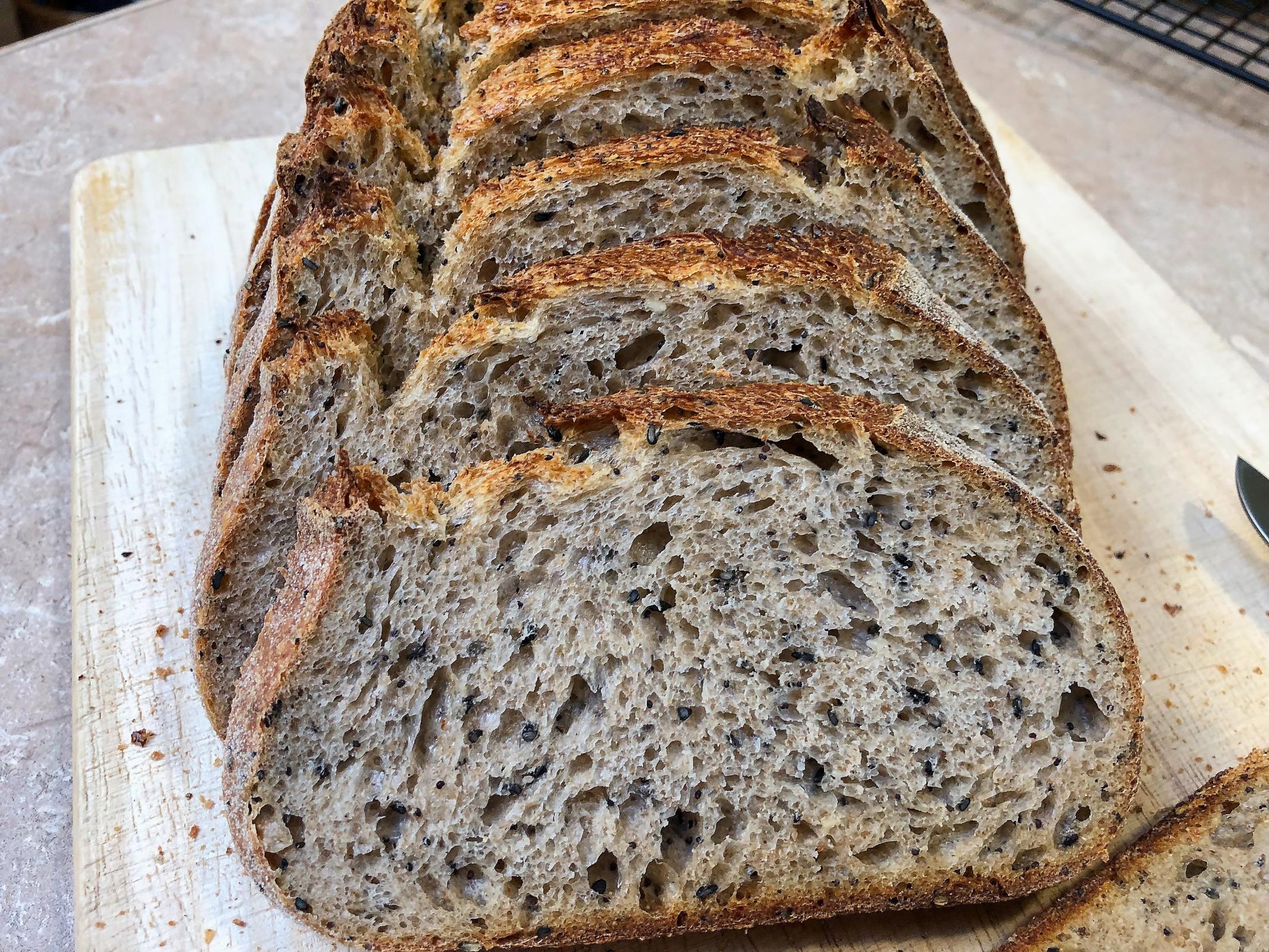
This year I have been baking a great deal more Whole Grain bread, and I have been intrigued especially by the work of danni3ll3. I have several bakes from her blog in my bookmarks. This is based fairly closely on one of them. There are some variations though: I had no Spelt grain or flour, so I left it out and made up the weight in the Red Fife. I used low fat yogurt since that is what I had. I ran short of Black Sesame so I made up part of it with "regular" sesame, and the balance with poppy seeds. These variances are not indicated in the formula below, however. I too milled all of flours but for the bread flour myself, but a couple of days before I needed it because it wasn't convenient to wait till the evening before bake this time. I don't usually get my bulk ferments to go as long as she specified, but this batch went the full 5 hours (well, 4.5 hours anyway). Also, I proof seam side up, and bake seam side down. Her results are beautiful using her seam-up approach, but I'm a coward. I imagine horrors of loaves blowing wide open like bloated butterflies baking seam side up! I also always proof on linen clothes in my bannetons when the loaves go in the refrigerator overnite. Too many loaves have been lost sticking to the banneton when I've tried it without. So, I use the cloths. I also never seem to need to bake as long to get to full internal temperature. My oven bakes HOT, even though it is right on the setting for temperature. So, I just keep an eye on things, and test internal temp early. Even so I usually end up with internal temps 4-7 degrees hotter than specified (with all my bread, not just these).
And of course, the crumb shot

| Ingredients | Total (gm) | Levain (gm) | Final Mix (GM) |
| Water | 739 | 127 | 612 |
| Bread Flour | 671 | 671 | |
| Whole Emer Flour | 94 | 94 | |
| Whole Rye Flour | 56 | 56 | |
| Whole Einkorn Flour | 94 | 94 | |
| Whole Red Fife Wheat Flour | 304 | 304 | |
| Plain Yogurt | 36 | 36 | |
| Black Sesame Seeds | 54 | 54 | |
| Salt | 18 | 18 | |
| 100% Hydration Starter | 32 | 32 | |
| Levain | 324 | ||
| Yield | 2100 | 324 | 1056 |
| Total Flour | 1220 | 164 | 1056 |
Method
1. HOLD BACK 90gm water
2. Add all ingredients except for salt and Levain to mixer bowl and mix briefly to shaggy dough.
2.1. Autolyse for 3 hours
3. Add Levain, salt and half the held back water, and mix till well combined. Add more water as
needed
4. Mix till not quite moderately developed
5. Bulk ferment till doubled, with 4 sets of stretch and folds every 30 minutes (5 hours per
author)
6. Divide, pre-shape and rest for 15-20 minutes
7. Place in bannetons, bag, and proof overnight in refrigerator
Bake
Preheat tiles/stone/steel and Dutch ovens at 485F
Bake loaves 20 minutes at 485F, TURN DOWN to 450F for 10 minutes, then remove DO lids and bake till internal temperature is 200F+ (20-25 minutes)
If you try it, I think you will like it!
OldWoodenSpoon
- OldWoodenSpoon's Blog
- Log in or register to post comments
Great looking crumb!
Best,
Ian
Thank you for the kind words! The flavor was very good too Not just a pretty picture! :).
OldWoodenSpoon
... especially with all the emmer, einkorn, and rye. I do wonder why you don't just turn the preheat and baking temperatures down a little.
TomP
Thanks Tom! I was very pleased with the results I got in this bake: good spring, a nice open crumb, and excellent flavor. For so much whole grain the crumb has a tender, creamy texture, yet is strong enough to hold together for things like today's salami and cheese with whole grain mustard. :)
Yes, starting with lower initial oven temperature made sense to me too, but experiments with this approach yielded less oven spring on anything proofed overnite in the refrigerator and then baked without morning bench time. I concluded that the high initial temperature is necessary to get that explosive bloom from the cold dough. I also found that whole grain loaves can overproof very rapidly with morning bench time, so I've resolved to stick with the high initial temperatures whenever I bake directly from the refrigerator. The approach that has yielded very good loft, and avoids the possibility to over proof on the bench in the morning. Your suggestion works well with yeasted breads, for anything not proofed overnite in the refrigerator for that matter, so for those breads I make the adjustment.
Thanks for your thoughtful comments
OldWoodenSpoon
... and your loaves are pretty good size so there's even more chilled dough to heat up rapidly.
Those are spot on, really well done. They look incredible inside and out.
Benny
Thank you for the high praise!
OldWoodenSpoon
And great crumb for the amount of wholegrain (and seeds!).
I do have a few of Danni's recipes bookmarked, but never got round to making them; I must give them a try.
Lance
Thank you! This was a fairly challenging dough. There was enough einkorn and emmer flours to make it sticky, especially in the early folds. By the fourth/last fold that had sorted out, and the dough had developed well. At shaping it had plenty of strength and held shape well. All those things helped the crumb to turn out so well.
Danni has some real gems in her collection. This is one of my personal favorites, and reaction from those I gifted loaves to were very enthusiastic. You really should dig into some of them.
Thanks for your comments.
OldWoodenSpoon
Beautiful crumb indeed, especially consider the addition of all of those lovely ancient grains. Impressive!
-Jon
It was so good we finished it at breakfast this morning. Now I can bake again. :)
OldWoodenSpoon